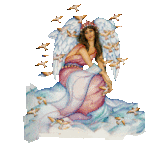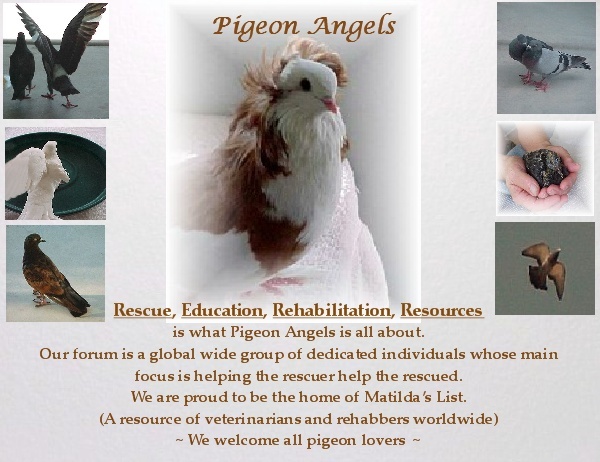|
| | Virus that Affect Pigeons |  |
| | | Author | Message |
|---|
Matilda
Special Pigeon Angel

Posts : 9198
Join date : 2009-01-11
Location : Pacific Northwest of the United States of America
 |  Subject: Virus that Affect Pigeons Subject: Virus that Affect Pigeons  Sun Jan 24, 2010 3:50 pm Sun Jan 24, 2010 3:50 pm | |
| Adeno-Coli Syndromhttp://www.belgicadeweerd.nl/bdwenglish/ziektes.htmhttp://www.oropharma.nl/en/duiven/html/diarree.htmlhttp://www.hinckley-bosworth.gov.uk/pp/pressrelease/pressdetail.asp?id=5302http://www.pigeonland.co.uk/article_read.asp?item=31) ADENOVIRUS. In Europe, two different adenoviral infections are known to occur in pigeons, and are designated Types I and II. Type I was discovered in 1976, and occurred in young pigeons during the first half of the year, with a peak frequency in June. The major sign of this adenoviral disease was watery diarrhea. E.coli often complicated this disease, and resulted in a more severe diarrhea, as well as vomiting and occasionally, death. Treatment with appropriate antibiotics was often successful. At post mortem of affected birds, there was evidence of enteritis (inflammation of the intestines), and the liver was often normal or only mildly abnormal. However, microscopically in the liver, there were characteristic changes that indicated adenoviral infection. Type I adenoviral infection seems likely to be the disease that affects many young birds over the world today. Type II adenoviral infections occurred in Belgium in 1992, and were characterized by sudden death in pigeons of all ages. There were very few clinical signs in affected birds prior to death. Occasionally, there was fluid, yellow diarrhea and vomiting. However, the major sign was sudden death within 24 hours of the onset of illness, with none of the obviously sick birds surviving longer than 48 hours. Antibiotics had no effect on the outcome of this disease. In individual lofts, losses were variable, and usually amounted to 30%, but in some cases reached 100%. At post mortem, affected birds had a pale, yellow, swollen liver that had a characteristic red sheen. Microscopically, there was massive destruction of the liver, along with typical changes indicative of adenoviral infection. Although this infection began by affecting one age group in a loft, in 70% of cases, the disease eventually spread to all age groups. To the surprise of investigators, in lofts in which these acute deaths occurred, pigeons that did not die remained completely normal. Even youngsters in the nest grew normally after their parents died of this infection, if they were able to feed themselves or were raised by other pairs. Whether Type II infection has yet occurred in North America is not known to me. | |
|   | | AZWhitefeather
Owner/Administrator

Posts : 10863
Join date : 2009-01-11
Location : Arizona Southwestern United States
 |  Subject: Re: Virus that Affect Pigeons Subject: Re: Virus that Affect Pigeons  Sun Jan 24, 2010 4:14 pm Sun Jan 24, 2010 4:14 pm | |
| Thanks for the links, Charis. | |
|   | | Matilda
Special Pigeon Angel

Posts : 9198
Join date : 2009-01-11
Location : Pacific Northwest of the United States of America
 |  Subject: Re: Virus that Affect Pigeons Subject: Re: Virus that Affect Pigeons  Sun Jan 24, 2010 4:16 pm Sun Jan 24, 2010 4:16 pm | |
| Circovirushttp://www.pigeoncote.com/vet/circo/circo.htmlhttp://www.auspigeonco.com.au/Articles/Young_Bird_Disease.htmlhttp://www.browardcountypigeonclub.com/Pigeon-diseases.htmlCirco Virus Cause and Symptoms - Because of the way this disease damages the immune system and seems to invite secondary infection, Circo Virus is sometimes called pigeon AIDS. Circo Virus damages the lymphocytes in the blood, which are closely associated with the immune system. With damaged lymphocytes, the pigeons become susceptible to secondary infections with other viruses, parasites and bacteria. Pigeons infected with Circo Virus can also have continuing problems with diseases like respiratory infections, chlamydia, or canker due to the fact that they cannot form natural immunities to them. Most often, Circo Virus kills very young pigeons and strikes older youngsters that have already molted three or four flights. Birds with Circo Virus have a yellowish discharge dried on the beak, and they are very reluctant to move, thin and dehydrated, and have no appetite and difficulty breathing. But it is extremely hard to diagnose Circo Virus by looking at the birds. The signs that can be observed are typically caused by many different types of secondary infections. Prevention - Use of improver and AntiFungal while keeping the disease out of the loft by not introducing birds from lofts known to have health problems. Stray youngsters should be immediately removed if they do not look well, and try to identify carrier stock birds by re-pairing those whose offspring seem weak or die. If the virus comes into four loft, minimize its spread by taking sick birds out immediately and isolating them while giving them full doses of Improver, paying attention to on-going hygiene. Good care, given day to day, places your pigeons in the best situation to resist infection, and gives those that become infected the best chances of recovery. The main defense against. Circo Virus is to identify and treat secondary infections, allowing the birds to live long enough for immune system to repair itself. Probiotics help well birds resist the disease by maintaining a healthy bowel population of bacteria. | |
|   | | Matilda
Special Pigeon Angel

Posts : 9198
Join date : 2009-01-11
Location : Pacific Northwest of the United States of America
 |  Subject: Re: Virus that Affect Pigeons Subject: Re: Virus that Affect Pigeons  Sun Jan 24, 2010 4:34 pm Sun Jan 24, 2010 4:34 pm | |
| Herpes Virus http://www.epah.net/birds/Herpesvirus.htm |
Dave Rupiper DVM
Kenneth T. Briggs DVM, PhD
Herpes virus, also known as Infectious Catarrh, is a a contagious, persistent virus causing respiratory and neurologic disease in pigeons. In its breadth of clinical signs, occasional virulence and persistence in carrier birds, Herpes infections of pigeons somewhat resembles diseases caused by similar Herpes species in other domestic animals. (Fortunately, Herpes infections are very specific to their natural hosts -- we can't infect our birds with our varieties, nor can we contract the pigeon forms!) Birds having Herpes infections are often concurrently infected with Mycoplasma, Chlamydia (Psittacosis/Ornithosis) and bacteria.1 As a result, signs of disease may not always be straightforward. Herpes virus was first identified in pigeons in the U.S. in 1945 and in other countries during the next 40 years.2 Multiple types of Herpes virus affect other species such as raptors, waterfowl, psittacines and poultry.2,3
Herpes virus in pigeons may be of two or three different forms. The most common form, Pigeon Herpes Virus (PHV), may cause mild respiratory and liver diseases. Two strains of PHV have been isolated, mild and severe PHV.4
The second form, Pigeon Herpes Encephalomyelitis Virus (PHEV), may cause paralysis, torticollis (twisted necks and rolling) and other neurologic signs without causing respiratory signs, making it difficult to distinguish between PHEV and Paramyxovirus. Fortunately, PHEV has not been reported to be a significant problem in the U.S. but may be observed in birds imported from the Middle East.
The third reported form of PHV causes inflammation of the cloaca and vent but the distinctiveness of this form has not been confirmed.2
Etiology (Cause) and Transmission: Herpes virus belongs to a group of DNA viruses known as the Herpeviridae which includes the viruses which cause Marek's Disease of poultry, Duck Plague, psittacine Pacheco's disease, and Infectious Laryngotracheitis of chickens.5 PHV is usually passed from affected adults to squabs during feeding. It can be transmitted by nasal discharge as well as in saliva, feces and urine. In most flocks, PHV is already present but birds only manifest signs if the strain is severe, as with PHEV, or the birds are stressed by management problems and concurrent diseases.
Signs: PHV causes upper respiratory signs. These include reddening of the eye, cere and lids, nasal discharges, graying and filming of the mouth and oral cavity, and occasionally open-mouthed breathing. These respiratory signs and discharges are referred to as "catarrh." Other symptoms include fluffed posture, depression, diarrhea, weakness during flight and anorexia.
PHEV causes neurological signs such as paresis ( muscle weakness), paralysis, circling, seizures and twisted necks. PHEV is also much more severe than PHV and may result in rapid and high mortality within a loft.
Diagnosis: The classic diphtheritic (filmy slime in the mouth) upper respiratory signs are fairly diagnostic for PHV but may be confused with the "Ornithose Complex" involving concurrent infections of Mycoplasma and Chlamydia. Diagnosis is most easily achieved via necropsy (autopsy) of an affected bird. Special staining of the spleen and liver allows a pathologist to identify special inclusions within the cells which are called "intranuclear inclusion bodies" or "INI bodies." The liver and spleen often have tissues damaged with PHV.
Treatment: There is no cure for the disease and only through improved management can we hope to achieve control.6 Treatment with a drug called acyclovir may help control severe signs but the disease often returns if the medication is discontinued. It is best to allow Herpes virus to run its course and let the birds develop a natural immunity. Passive immunity (antibodies are transferred from parents to squabs in "crop milk") protects the young until weaned. Isolation of obviously affected birds is recommended since they are often infected with other contagious diseases as well.
Prevention: Killed and live virus vaccines have been formulated, but these only prevent shedding and dissemination of the virus from affected birds. Vaccines do not prevent pigeons from being carriers of Herpes virus.2,5 Natural infection of mild strains with subsequent immunity is still the best method to protect a flock from virulent strains of PHV.2
Like so many diseases of our birds, prevention and treatment often depend on cleanliness, good husbandry, good nutrition and preventing overcrowding. The days of keeping six inches of dry litter on the loft floor to prevent disease are gone, just as using NFZ to control canker and Paratyphoid is obsolete. Intense competition at shows, performance flying of young birds and increased production of squabs are placing more demands on the fancier in order to still be competitive. The key to success is educating ourselves about the disease process and by progressive management of our lofts.
References
1. Schrag L: Healthy Pigeons, 6th English Revised Ed, Hengersberg, W Germany, Schober Verlags-GmbH, 1989, pp 48-53.
2. Tudor DC: Pigeon Health and Disease, Ames, IA, IA St Univ Press, 1991, pp 34-38.
3. Fraser CM (Ed): Part VI, Diseases of Poultry. in Merck Veterinary Manual 6th Ed, Rahway, NJ, Merck & Co., Inc., 1986, p 1272.
4. Kaleta EF: A Selection of Disease Syndromes in Pigeons. Proc 1st Conf European Comm AAV, 1991, pp 77-81.
5. Dorrestein GM: Viral Infections in Racing Pigeons. Proc AAV, 1991, pp 244- 257.
6. Marshall R: Management of Pigeon Diseases. Proc AAV, 1990, pp 122-135. | |  |
|
| |
|   | | Matilda
Special Pigeon Angel

Posts : 9198
Join date : 2009-01-11
Location : Pacific Northwest of the United States of America
 |  Subject: AdenoVirus, E-Coli and Paratyphoid Subject: AdenoVirus, E-Coli and Paratyphoid  Tue May 25, 2010 7:40 pm Tue May 25, 2010 7:40 pm | |
| | |
|   | | AZWhitefeather
Owner/Administrator

Posts : 10863
Join date : 2009-01-11
Location : Arizona Southwestern United States
 |  Subject: Re: Virus that Affect Pigeons Subject: Re: Virus that Affect Pigeons  Tue May 25, 2010 11:29 pm Tue May 25, 2010 11:29 pm | |
| Appreciate you posting the link, Charis.  | |
|   | | Sponsored content
 |  Subject: Re: Virus that Affect Pigeons Subject: Re: Virus that Affect Pigeons  | |
| |
|   | | | | Virus that Affect Pigeons |  |
|
Similar topics |  |
|
| | Permissions in this forum: | You cannot reply to topics in this forum
| |
| |
| |


